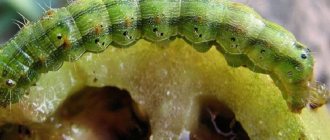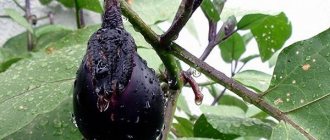The death of tomatoes from caterpillars is a problem familiar to many gardeners. Most often, plantings are affected by the tomato cutworm, whose peak activity occurs in mid-summer. In just 20 days of being in the caterpillar stage, this pest can leave a farmer without a harvest.
Preventive measures will help prevent the appearance of armyworms in garden beds. If it is not possible to protect the plantings from damage, they use “heavy artillery” - contact-intestinal insecticides. Along with them, folk remedies and entomophages (microscopic insects) are used. They destroy the pest no less effectively and allow you to collect an environmentally friendly product.
How to treat tomatoes against caterpillars in a greenhouse? What drugs are the most effective? You will receive detailed answers to these and other questions in the article.
Parasitic larvae on tomato beds
Not all types of caterpillars are attracted to juicy tomatoes. Tomatoes are most often parasitized by the larvae of two types of butterflies - whiteflies and cutworms. They actively eat the fruits and leaves of the plant. You can encounter pests not only in the open ground, but also in the greenhouse. It's not just the larvae that pose a danger. Butterflies damage tomatoes because they carry bacteria and viruses. Because of insects, plants begin to get sick.
This manifests itself in different ways:
- tomatoes stop growing;
- tomato fruits are deformed;
- The yield decreases due to the lack of ovary.
Whiteflies and cutworms can harm more than just tomatoes. They fly to neighboring vegetable crops. Insects pose a threat to zucchini, eggplant and sweet peppers.
Whitefly larvae
It is difficult to notice the pest on plant leaves. The size of the whitefly is only 1.5-3 mm. The body of the butterfly is white or yellowish, the wings are completely snow-white. The insect does not fly alone. Usually there are dozens of butterflies sitting on a branch. To detect them, you need to shake the plant trunk. The whiteflies will fly up, forming a white cloud.
Insect larvae are initially transparent, with a greenish tint. They feed on plant sap and live on the inside of leaves. During a cycle, the caterpillar goes through several stages. Young larvae are very mobile. They constantly move, destroying healthy and succulent leaves. Caterpillars secrete a sticky secretion that contains a lot of sugar. Because of this, the plant becomes infected with sooty fungus.
The foliage is covered with a black coating, which slows down the processes of photosynthesis. Without receiving the proper amount of sunlight, the plant gradually dies. Caterpillars on tomatoes spoil not only the foliage, but also the fruit. Tomatoes are covered with a white coating.
The liquid that whitefly caterpillars secrete attracts ants to the area. These insects can introduce aphids into the area, which can cause enormous harm to immature tomatoes.
When the caterpillar is ready to change into a butterfly, it slows down. The body of the insect is covered with a waxy coating. Instead of transparent, the color becomes light green. The green caterpillar on tomatoes in a greenhouse is resistant to chemicals. Treating tomatoes with pesticides and insecticides during this period will not bring results. The wax cover will protect the caterpillar from toxic compounds.
You should be wary of whiteflies when there is high humidity and air temperatures above 10 degrees. Caterpillars and butterflies die at the beginning of frost. But whitefly eggs survive cold weather. Butterflies deposit them in the upper layers of the soil, where the insect can remain until the next season.
Whiteflies live not only on tomatoes. Caterpillars can eat many indoor plants:
- begonias;
- fuchsia;
- balsams;
- passion flowers;
- pelargonium.
They pose a danger to potato beds and greenhouse peppers.
Armyworm larvae
The butterfly is a small moth of inconspicuous gray color. The insect's wingspan is less than half a centimeter. Butterflies lay eggs in the ground. Two weeks are enough for the larvae to emerge. The life cycle of a caterpillar before becoming a butterfly is 40 days. During this time, it causes significant damage to the crop.
Cutworms pose a threat to more than just tomatoes. Caterpillars eat beds of cabbage, beans, beets, rutabaga and eggplant.
Armyworm larvae, depending on the subspecies, may differ in color. Most caterpillars are green. There are individuals in brown-pink color. Their length does not exceed 30 mm.
The caterpillar eats tomatoes from the inside. It moves in tomato stems and also feeds on leaves. When the plant begins to wilt and the greens cease to be fleshy, the insect moves to the fruits. The gnawing subspecies of cutworm poses a danger to the root system of the plant. They can feed on underground areas of stems.
The cutworm caterpillar must be combated when the larva emerges from the egg. It is impossible to calculate this period in advance. After the caterpillar is born, there are several days during which it can be noticed on the plant. The caterpillar then chews through the tomato stem, making it very difficult to see.
Why do I get rid of caterpillars in the greenhouse?
I always try to prevent pests from appearing in my area. If uninvited guests show up, without wasting time, I begin processing the plants. Being late threatens the destruction of plantings and serious damage to the harvest.
Caterpillars, one of the most voracious pests, are especially dangerous here. If measures are not taken in time, they will deprive the harvest. Such pests can be found not only in open garden beds, but also in greenhouses. In the comfortable conditions of a greenhouse, they are active and voracious. They practically do not have to fear natural enemies - birds, predatory insects.
Having discovered caterpillars in the greenhouse, I turn to proven folk methods. If the method is not effective, turn to specialized chemicals. And I don’t forget about preventing the appearance of these gluttonous enemies.
Reasons for appearance
Plants should be inspected for pests especially carefully in several cases:
- Humid climate. Heavy rains and hot air are ideal weather for caterpillars to hatch from eggs. The soil in which the masonry is located becomes warm enough, which becomes a signal for insects.
- Abundance of fruit crops. If there are areas with vegetable gardens and orchards near a summer cottage, there is a high probability of caterpillars appearing. Butterflies quickly move through the air and capture new territories.
- Weed grass. During the flowering period, weeds attract pests to the site.
- Poor soil treatment. Butterflies lay eggs in the ground. To destroy the masonry, you need to dig up the top layer of soil. The minimum processing depth is 15 cm.
Fine-grained insect netting will help get rid of caterpillars in a greenhouse. It will not allow butterflies inside, which will protect the plants from pests.
Natural enemies of the cutworm
Birds peck the scoop from tomatoes, so in winter the birds need to be fed, and in summer they need to be attracted to the site in every possible way.
Butterflies have their own parasites:
- bracon;
- black banhus;
- tachina fly.
There are Trichogramma on sale - egg-eating insects that parasitize the cutworm. Their use is especially effective on tomatoes in greenhouses. They find a clutch of armyworms and release their own eggs inside. Trichogramma are less prolific than the pest. But they give 2-3 generations per 1 generation of armyworm.
External manifestations of caterpillar activity
You can notice that pests have appeared on tomatoes based on several signs:
- The tomato leaves are covered with a white coating.
- Holes appear in green fruits.
- The foliage turns black, quickly dries out and falls off.
- The tomatoes turn dark brown and fall off the branches.
- At night, white and gray butterflies fly over the tomatoes.
You can check for caterpillars in your area using a butterfly trap. To make it, a regular plastic bottle with a narrow neck is suitable. Sweet fermented liquid is poured inside. Kvass, jam or berry compote will do. The trap is set at night. If in the morning there are several pest butterflies inside the jar, parasitic caterpillars have settled on the tomatoes.
Signs of defeat
The main reasons for the appearance of cutworms on a personal plot are considered to be insufficient preparation of the soil before planting seedlings and the lack of disinfection. Due to the refusal to dig up the soil in autumn, most cutworm pupae survive.
The source of the spread of pests can be plant debris in the garden, the remains of last year's plants, as well as weeds, which provide additional food for the cutworm.
Provoking factors also include improper destruction of bushes and fruits affected by cutworm caterpillars - for example, adding them to a compost heap rather than burning them.
The armyworm is nocturnal, so it is extremely difficult to detect it in the beds. During the daytime, pests hide in the soil. Tomato pests can be identified by characteristic signs:
- whitened spots on tomato foliage covered with white round eggs;
- the appearance of green or brown caterpillars on the leaves in the evening;
- small holes on the leaf blades, which gradually increase in size, leaving only veins;
- traces of gnawing on flower buds and fruit ovaries;
- eaten away holes on ripening fruits;
- blackening, drying out and falling leaves;
- dark brown tint of tomatoes and their rotting.
Cutworms pose a huge danger to the garden. In the absence of tomatoes, they begin to eat other vegetable crops. The damaged plant quickly dries out, the fruits rot, and as a result the bush dies.
How to spray tomatoes against pests?
To combat caterpillars on tomatoes, you can use several methods. Using insecticides, you can get rid of pests in one treatment. But using chemicals is dangerous during the fruit ripening period, since the poison can get into the food. If the first tomatoes appear on the plant, it is worth using traditional methods. They are not as effective, but are safe for humans.
Chemical insecticides
Treatment with toxic substances is carried out in emergency cases. It is advisable to resort to potent drugs when pests threaten most of the crop.
Effective insecticides against caterpillars include:
- "Inta-Vir". The drug can be used no more than 2 times per season.
- "Decis". The advantages of this product are fast action and lack of addiction in insects. Can be used once a season during active tomato growth.
- "Avant." Treatment should be carried out during the growing season of plant growth. It is recommended to water the area with the drug once a year. "Avant" destroys not only caterpillars, but also butterfly eggs in the ground.
- "Aktara". The drug is effective against one hundred species of insects. It poisons not only caterpillars, but also other common pests - aphids and the Colorado potato beetle.
Insecticides are removed from the plant naturally 30 days after spraying. It is not recommended to use them during the period when tomatoes bear fruit.
One preparation is not suitable for annual treatment. Insects quickly become immune to the composition of chemicals.
Organic preparations
Biological-based insecticides can be used several times per season. They are safe for humans, do not poison fruit crops and are not addictive to insects.
Organic preparations for protecting plants from caterpillars include:
- "Lepidocide." It repels butterflies and quickly kills caterpillars.
- "Aktofit". Two treatments with this product are carried out per season for optimal results.
- "Biostop". Effective in the fight against cutworms and aphids.
- "Fitoverm". For optimal results, the area is treated with the product twice during the spring-summer period.
- "Verticillin". The drug is made from a fungus that is toxic to insects. It quickly destroys butterflies and whitefly caterpillars.
Tomatoes after treatment with bioinsecticides can be harvested after a few days.
Folk recipes
Using improvised means, you can prepare an effective solution against pests. Spices have repellent properties. Such as salt or mustard. You can also reduce damage from caterpillars by poisoning the pests with a concentrated infusion of herbs.
Saline solution
To prepare the mixture, 400 g of table salt is dissolved in 5 liters of water. The composition is used to treat leaves, both from the outside and from the inside. To keep the salt on the surface of the plant longer, you can add shavings from laundry soap to the mixture.
Mustard powder solution
Dry mustard must be poured into boiling water. 100 g of powder is used per bucket of water. The solution is infused for 48 hours. Then you can spray it on infected plants.
Wormwood decoction
For 1 liter of boiling water there are 100 g of chopped weeds. The decoction is infused for 2 days. The resulting concentrate must be diluted with water in a ratio of 1:10.
Tobacco infusion
300 g of tobacco dust is poured into one bucket of boiling water. The solution is infused for a day. To make it last longer on the leaves, you need to add a third of the bar soap to the infusion.
Garlic water
Garlic has a detrimental effect on caterpillars. To make the solution, you need to chop 700 g of plant arrows and pour hot boiled water over them. The broth is infused in a closed container for a week. You need to use 50 g of concentrated infusion per bucket of water. The product can be sprayed on tomatoes once every 10 days.
When to treat a greenhouse
The greenhouse must be treated twice a year. In order to grow healthy garden crops indoors, you need to create safe conditions. A brush is used to clean heavily soiled areas.
Treatment of the greenhouse in the spring is carried out in the form of soil disinfection with the help of biological preparations, such as: phytosporin, azotophyte, pentafog, stubble biodestructor, trichodermin and phytocide. The use of these drugs will help strengthen the results of spring treatment, and they are carried out annually.
Autumn treatment consists of:
- fumigation;
- soil disinfection;
- processing elements located indoors;
- cleaning up debris, dry plants and leaves;
- external treatment, which includes the use of a soap solution.
What plants repel caterpillars?
Pests will avoid places where bird cherry bushes grow. Many useful and medicinal plants repel caterpillars:
- mint;
- calendula;
- coriander;
- sage;
- thyme;
- thyme.
Butterflies are afraid of strong odors. Cutworms and whiteflies are repelled by certain types of flowers, such as geraniums, cornflowers and marigolds.
Advice! At the beginning of spring, white mustard seeds can be planted in future tomato beds. When the plant sprouts, it will saturate the ground with its scent. After this, the soil is loosened and tomato seedlings are planted. Butterflies will not be able to lay eggs in such soil.
Greenhouse treatment in autumn
Removing vegetation residues
These residues can serve to overwinter harmful microorganisms. If the vegetation was affected by the disease, it is burned. Healthy greens can be used to make compost.
Cleaning harnesses and supports
Pests can also live on harnesses and supports. It is better to burn them or take them outside the greenhouse. Reusable metal supports are also treated together with other room elements.
Greenhouse flushing
Wet cleaning plays an important role and gets rid of viruses, contaminants, fertilizers, spores, fungi and chemical treatment residues. Polycarbonate is unstable to light damage, so wet cleaning must be done using microfiber cloths or soft sponges.
For washing, use warm water and laundry soap (detergent). The entire internal surface is cleaned with soap foam; special attention should be paid to the joints of the frame with the polycarbonate coating. The soap suds are left for 10 minutes and then washed off with the hose. After washing the inner surface, you need to start washing the outer surface. This procedure will make it easier to clear snow and ice in winter.
Biological methods
In nature, the enemies of pest caterpillars are Trichogramma. They lay eggs in the cocoons of butterflies, thereby destroying garden pests. Insects can be purchased at a special store. They are released onto tomato bushes 3 times per season. It is necessary to plant 5000 trichograms per 1 hectare of land.
Bracones pose a danger to caterpillars. These are predatory flies that parasitize the larvae of other insects. The females pierce the caterpillar's cover and inject poison, which stops the digestive system. Then the adult injects about 20 larvae into the victim’s body. Bracons eat the caterpillar from the inside until they reach adulthood.
Harm of cutworms
The potential fertility of the cutworm is 2 thousand eggs. It is especially unpleasant that some species lay one butterfly per leaf, and one butterfly can infect a huge area. Other cutworms can leave 300 or more eggs on the underside of a tomato leaf blade.
Butterflies do not pose a danger to tomatoes, and even bring some benefit by participating in pollination. The pests are larvae that live quite a long time.
If in the south their development can last 2 weeks, then in the northern regions the caterpillars of the Winter Armyworm sometimes feed for up to 100 days until they pupate.
During the day, the larvae hide under leaves or plant litter, and feed in the evening and at night. Cutworm - crop pests are conventionally divided into three groups:
- leaf-eaters, whose food base is tomato leaves;
- gnawing cutworms damage the roots and lower part of tomato shoots, most belong to the Agrotis subfamily;
- intrastem ones gnaw into soft tissue, live and feed inside the plant until the time comes to pupate.
But it’s not for nothing that moths are called omnivores. Caterpillars in the early stages of development usually skeletonize and gnaw tomato leaves. Then they may well move onto tomato fruits, damaging them in the area of the stalk.
Gnawing cutworms prefer not to rise high; they feed on flowers and tomatoes if they lie on the ground.
Caterpillars of the first and second groups damage tomato fruits only when they spread strongly. If the beds and greenhouses are treated, their “activity” will, although it will affect fruiting due to inhibition of bush growth, but only a few ovaries will be eaten away.
How to properly process tomatoes?
Proper care of tomatoes reduces the risk of caterpillars appearing on the site. Plant processing methods differ depending on the location where the fruit crops are located.
Outdoors
The larvae can infect the soil when planting seeds that have parasites. To prevent this from happening, you should always treat the seedlings. The disinfection solution is prepared on the basis of potassium permanganate. For 1 liter of water, 1 mg of the product is used. The seeds are placed in the solution for 15 minutes. Afterwards they are washed thoroughly. They can then be sprouted or dried and used later.
Sprinkling the soil with tobacco dust will help control caterpillars on the site. The eggs of butterflies will die in it, due to which the population of larvae will decrease. If few insects are noticed, it is worth spraying the leaves with herbal infusion. Every other day you can wash off the sticky sweet coating that is secreted by several species of larvae. In this way, you can protect the plant from the formation of fungus.
In case of massive insect infestation, it is worth using organic or chemical preparations for treatment.
In greenhouses and greenhouses
There are many butterfly traps you can set up in an enclosed area. Sticky fly strips will help reduce the number of insects. You can also lay out sheets of plywood or boards coated with a sticky and sweet solution in the greenhouse.
It is only possible to completely get rid of caterpillars in a greenhouse using insecticides. It is important to follow the processing instructions so as not to exceed the permissible amount of chemicals.
Where does the cutworm come from on tomatoes?
In greenhouses, greenhouses and vegetable gardens, cutworm pupae and caterpillars overwinter in the ground. Suitable conditions in cold climates are created by plant residues that have not been harvested since autumn, warming the soil. Sometimes the armyworm enters the site along with purchased soil, “enriched” with the pest overwintering there.
Coming to the surface, the pest begins to feed on weeds. By the time crops are sown or planted, the cutworm is usually ready to lay eggs.
It is impossible to completely prevent its occurrence even by annual deep digging and disinfection of the soil in the fall. The armyworm flies well and can move from a neighboring area or migrate from afar.
Some species are capable of covering vast distances with air currents. In the Far East you can sometimes even find tropical cutworms. But they do not overwinter there and die at the end of the season.
Useful tips and advice
It is not advisable to plant tomatoes too close to each other. Because of this, it is convenient for pests to move to neighboring plants, and their population grows rapidly.
Tomatoes need daily watering. The soil must be moistened moderately so as not to create a favorable environment for caterpillars to reproduce. Tomatoes are watered early in the morning, when the sun has not yet had time to warm the ground. Water should only be poured at the root of the plant. It is also advisable to water the soil in winter. Because of this, insect pupae that are in the ground die.
Greenhouse treatment in spring
Spring and autumn processing are practically no different. In the spring, the remains of plants are removed, if they were not removed in the fall, and disinfection is carried out.
Disinfection in the spring will reduce the likelihood of pest spores and their larvae appearing in the soil. In the summer, pest activity will peak and this will negatively affect the yield.
Polycarbonate is also given a treatment to improve light transmission. Before cleaning, it is necessary to repair damaged structural elements.
The final stage includes processing the soil for further planting. There are times when the soil needs to be changed, and this is done in the following cases:
- the occurrence of plant diseases that grew in the greenhouse;
- the soil was depleted due to lack of agronomic crop rotation;
- when creating warm and high beds.
In addition to these methods, there are also traditional ones - adding organic matter, fluffing and loosening the soil.
Six stages of spring processing:
- freeing up space - containers for seedlings, shelving are taken out, supports are removed to strengthen the roof, which were installed in winter;
- replacement or repair of damaged frame elements (if any). Repaired items must be whitewashed with lime and paint glue;
- inspection of heating and watering equipment. If necessary, damaged pipes are repaired and painted;
- inspection of polycarbonate and replacement of sheets if necessary;
- garbage collection;
- disinfection. Cleaning polycarbonate and internal frame elements using wet cleaning. The entire room is fumigated.
Soil preparation includes adding fertilizers, additives and disinfection. It is advisable not to use chemical additives. Replace the soil if necessary.
Watch the video! Treatment of the greenhouse in the spring from pests and diseases
Prevention measures
To prevent larvae from appearing on the site, it is necessary to carefully monitor the seedlings. The likelihood of parasites appearing is low if:
- the top soil of the earth is completely replaced at the end of autumn;
- in spring the soil is treated with boiling water or a weak solution of potassium permanganate;
- there are no weeds in the garden;
- the greenhouse windows are protected with fine-grained mesh;
- In autumn, tomato tops are completely removed from the site.
The invasion of caterpillars can be easily stopped if measures are taken in time and the fruit plants are treated. Timely prevention will help reduce the number of pests on the site.
How to prevent infection
Prevention measures:
- the soil is dug up in the fall using the fall plowing method, without breaking up the earthen clods (the pupae end up on the surface and freeze);
- apply winter watering of the soil;
- remove plant debris with roots;
- in the spring, remove 15 cm of soil and replace it with new one;
- the place where tomato bushes are planted is treated with a strong solution of potassium permanganate or boiling water;
- the beds are weeded, removing weeds with roots;
- plantings are periodically thinned out, the lower leaves are removed;
- plants are watered strictly at the root in the morning;
- to prevent the penetration of moths into the greenhouse, mosquito nets are installed on doors and windows;
- Bushes are regularly treated with folk remedies.
Plants that repel armyworms
Celery is planted in the area between the tomatoes . The smell of the plant repels butterflies. Similar properties have: coriander, white mustard, calendula, basil, marigolds, geranium, wormwood, sage, thyme.
Step-by-step instructions for fighting
With a cutworm butterfly in the garden
The armyworm and the fight against it have a number of features . Read below on how to deal with cutworms in your garden.
- Prediction using pheromone traps. Traps show the exact time of the beginning of butterfly flight and the appearance of caterpillars. Initially, the summer passed during the flowering period of dandelions. But now all deadlines are shifted and extended in time. Therefore, forecasting is very important for timely action.
- In order not to poison plants with chemicals , you should first try to remove the cutworm using folk remedies.
- Attracting the cutworm's natural enemies - Trichogramma and Bracona.
- Hang bait traps throughout the garden.
- If the effectiveness is insufficient, biological products against cutworms are used .
- If they do not help to completely get rid of the butterflies, use the “heavy artillery”. For the fall armyworm, control measures should include chemical insecticides .
- When finishing the gardening season, it is worth digging up all the soil deeply, since cutworms overwinter in the soil. After digging, most of the pests die.
Now you know how to get rid of cutworms in your garden. About scoop caterpillars, how to fight further.
With caterpillars
- At the beginning of the season , dig the soil as deep as possible to reduce the number of overwintered pests.
- When planting, use alternation of different plant crops.
- Be sure to eliminate weeds that serve as the initial food supply for the larvae.
- When the first single specimens appear, they begin to be collected manually.
- If the number of caterpillars begins to increase, a means is selected to destroy them.
- If they are ineffective, biological products are replaced with chemical insecticides.
- After harvesting, deep digging of the site is again used .
It is recommended to use gentle drugs from the group of folk or biological ones.
The cutting armyworm methods for dealing with it are below.
With a gnawing scoop
- The main measure to reduce the number is digging up the soil to a depth of at least 25 cm . It is carried out twice a season - before planting and after harvesting. This procedure will get rid of most existing pests in the caterpillar and pupa stages;
- After planting the plants, they regularly loosen the soil between the rows and beds with a thorough inspection. All discovered caterpillars are immediately removed and destroyed;
- eliminate weeds not only in the garden, but also around the entire site;
- lure the gnawing moth butterfly fermenting drink - kvass, molasses, beer, compote;
- To destroy the larvae that live in the ground, it is necessary to use soil insecticides.
Some experienced gardeners use a tank mixture of the drug (1/2 of the required dose) with urea (100 g per bucket of water).
Control measures for cotton bollworm are slightly different, more on that below.
With cotton boll
The cotton bollworm is a quarantine pest against which special measures are taken . How to deal with it further.
Quarantine procedures include:
- unrelenting control over purchased seedlings, seedlings and bushes. Particular attention should be paid to cotton , chrysanthemums, tomatoes, corn, roses and eggplants. But remember that the cotton bollworm is an almost omnivorous pest;
- if a pest is detected, the entire batch of purchased sprouts is fumigated, as well as the container;
- widespread and active use of pheromone traps .
Photos of the scoop and the fight against it, see below.
How to deal with the scoop? The subsequent struggle is:
- In compliance with all rules of agricultural technology in closed greenhouses and in open areas.
- Constant monitoring and identification of pests at all stages of development.
- Thorough and timely removal of weeds and their subsequent burning.
- Preventive treatment of suspicious plants with chemical insecticides.
Read on for potato bollworm control measures.
Who harms tomatoes on the surface of the earth
The most common above-ground pests of tomatoes are armyworms and whiteflies.
The armyworm damages tomatoes at night. This caterpillar emerges from eggs laid by moths. First, the cutworm damages the apical leaves, and when it matures a little, it destroys buds, ovaries and flowers. But the sabotage does not end there. When the fruits appear, they are also attacked. The moth caterpillars make passages in them.
Two generations of armyworms appear during the season: from May to mid-July, from July to mid-September. Therefore, tomato pest control should be carried out throughout the season. You can determine whether the cutworm is harming your tomato harvest by leaving a jar of sour compote next to the plants overnight. If in the morning there are butterflies in it, then it’s time to take action. Planting calendula, spraying the leaves with an infusion of garlic arrows or its cloves, and an infusion of burdock leaves will help fight the cutworm.
Whitefly on tomatoes usually appears in greenhouses in the middle zone, and in the South in unprotected soil. When whiteflies appear, tomato leaves become covered with a black coating similar to soot. This is due to the fact that pests use plant sap for nutrition, and its excess forms a sticky film on which fungi settle. The plant withers and dies. To detect cutworms, just touch the plant and a white swarm of insects rises from it. The damage is caused by the larvae. It is at this stage that you can fight the armyworm. Plants covered with sticky substance stop breathing, so they need to be washed regularly with soapy water. Often this is enough. Special adhesive tapes are also very effective. Among biological methods, dandelion infusion works well. For this, leaves and rhizomes are used, filled with water and infused for 3 hours. You can also use a water infusion of garlic.
Don't lose your crop to pests. Don't miss the moment and don't let them multiply.
How to exterminate the garden cutworm?
Just like cabbage, potato and exclamation point, the garden cutworm is more than dangerous to the crop. The insect prefers tomatoes, cabbage and radishes, but is not averse to eating other types of crops. Caterpillars of this subspecies are usually green or brown in color.
The main danger of the pest lies in its habit of laying eggs on almost all crops indiscriminately. Typically, the insect chooses the inner surface of the leaf, where young larvae appear and consume fruits and leaves of plants.
Chemicals and traditional methods also have their effect if done correctly. So, for example, in the spring you can use Proteus, Fury, Decis - these are drugs for pest control. In summer, the effect can be achieved by treating crops with solutions of phosphorus, fufanol and zolon.
It is worth choosing drugs that are most convenient to use - in granules or powder. Concentrated emulsions require careful dilution and pose a major health hazard in case of skin contact.
Tips on folk remedies
To repel butterflies, you can spread or hang egg shells between beds of plants and rows .
Baits for catching adult cutworms are made from sweet drinks that can ferment. These include any syrups, molasses, kvass, juice, beer, liquid jam. Place the bait in small containers such as yogurt jars . Don't forget to remove any scoops you find.
Birds are very fond of cutworm larvae, so their attraction will significantly reduce pest populations. Flycatchers, titmice and sparrows are especially helpful . You can make feeders and nest boxes for them. Chickadees will be attracted to pieces of unsalted lard.
If you plant cilantro and basil next to possible victims, cutworms will not approach the plantings and will begin to fly around them, since they cannot stand the smell of these herbs.
Processing a greenhouse with perennial plantings
Often, greenhouse treatments can be done without cultivated plants, in spring or fall. In this case, many aggressive methods are used. But the question arises: how to handle greenhouses with perennial plants?
Today, growing raspberries in closed soil has become increasingly popular. The advantage is that raspberries have a dormant period when all fruit-bearing shoots can be removed. Preventive work is carried out after winter, with shoots pruned and plants removed. Disinfection is the disinfection of soil and equipment with various solutions (a concentration that will not harm raspberries) and mechanical cleaning indoors.











